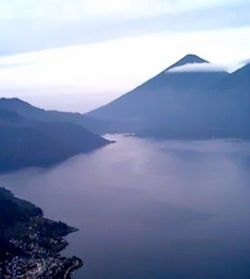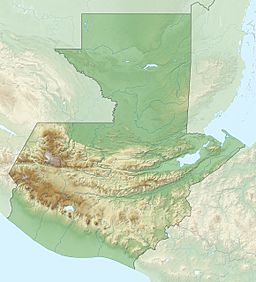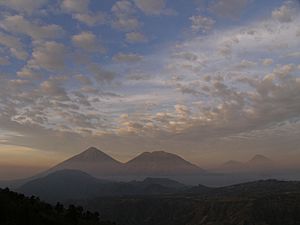Volcán Atitlán facts for kids
Quick facts for kids Volcán Atitlán |
|
|---|---|

Volcán Atitlán from the village of San Antonio Palopo
|
|
| Highest point | |
| Elevation | 3,535 m (11,598 ft) |
| Naming | |
| Language of name | Nahuatl |
| Geography | |
| Geology | |
| Mountain type | Stratovolcano |
| Volcanic arc/belt | Central America Volcanic Arc |
| Last eruption | May 1853 |
Volcán Atitlán (Spanish pronunciation: [atiˈtlan]) is a very large, cone-shaped active volcano. It is located right next to the huge caldera (a big crater formed after an eruption) of Lake Atitlán. This volcano is found in the highlands of Guatemala, within the Sierra Madre de Chiapas mountain range. It is in the Sololá Department, in southwestern Guatemala.
Contents
Volcán Atitlán: Guatemala's Active Giant
Volcán Atitlán has been quite active throughout history. Records show more than a dozen eruptions between the years 1469 and 1853. Its most recent eruption happened in May 1853.
How Volcanoes Like Atitlán Form
Atitlán is part of the Central American Volcanic Arc. This arc is a long chain of volcanoes that stretches across Central America. It formed because one of Earth's large plates, the Cocos Plate, is slowly sliding underneath another plate, the Caribbean Plate. This process is called subduction. When plates move like this, it creates heat and pressure, leading to volcanoes.
These volcanoes are also part of the larger Pacific Ring of Fire. The Ring of Fire is a huge area around the Pacific Ocean where many earthquakes and volcanic eruptions happen. It's shaped like a horseshoe and includes many of the world's most active volcanoes.
Atitlán's Neighbors
Volcán Atitlán is just a few miles south of Volcán Tolimán. Volcán Tolimán rises directly from the southern shore of Lake Atitlán. Another volcano, Volcán San Pedro, stands tall above Lake Atitlán to the northwest of Volcán Atitlán. A long, narrow bay separates Volcán Atitlán and Volcán Tolimán from Volcán San Pedro.
Amazing Animals of Atitlán
The cloud forests around Volcán Atitlán are home to some very special and rare birds. These birds are endemic to this region, meaning they are found nowhere else in the world.
The Horned Guan
One of these unique birds is the horned guan (Oreophasis derbianus). This bird is like a living fossil from the Pleistocene era (the Ice Age!). It belongs to the Cracidae family. Today, it only lives in small parts of its original habitat. You can find it in cloud forests that are higher than about 1,650 meters (5,413 feet) above sea level. This bird is about the size of a turkey. Adult male horned guans have a bright scarlet-colored "horn" that sticks straight up from the top of their heads, which is very cool!
The Azure-rumped Tanager
Another rare bird is the Cabanis's or azure-rumped tanager (Tangara cabanisi). This bird has one of the most limited ranges of any species in the region. It is only found at middle elevations within the Sierra Madre del Sur mountains in Chiapas, Mexico, and western Guatemala. Its beautiful blue rump makes it easy to spot.
See also
 In Spanish: Volcán de Atitlán para niños
In Spanish: Volcán de Atitlán para niños
- List of volcanoes in Guatemala



